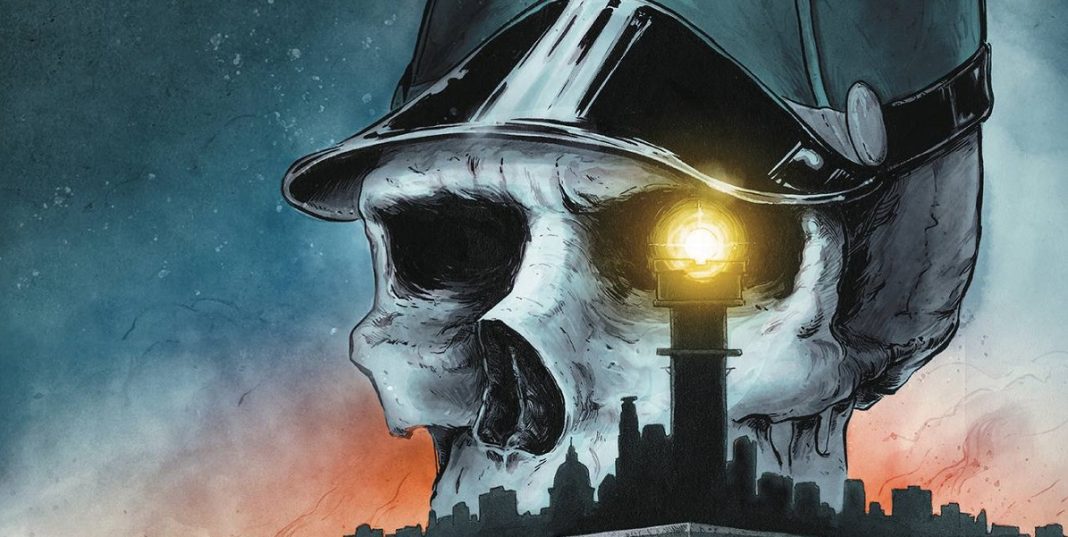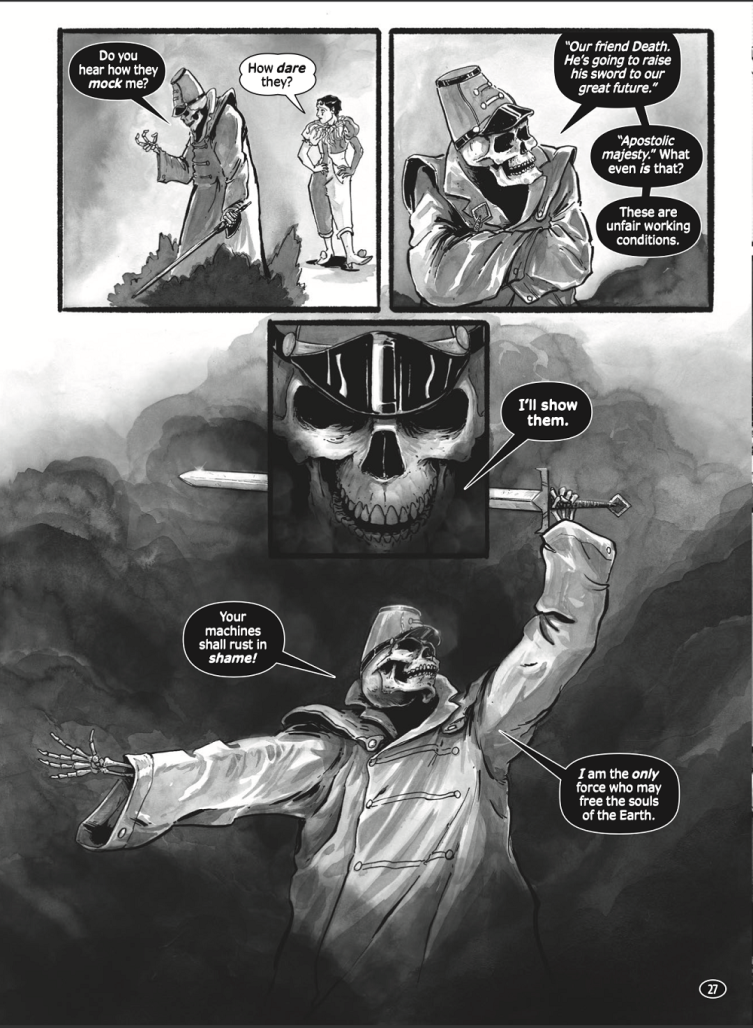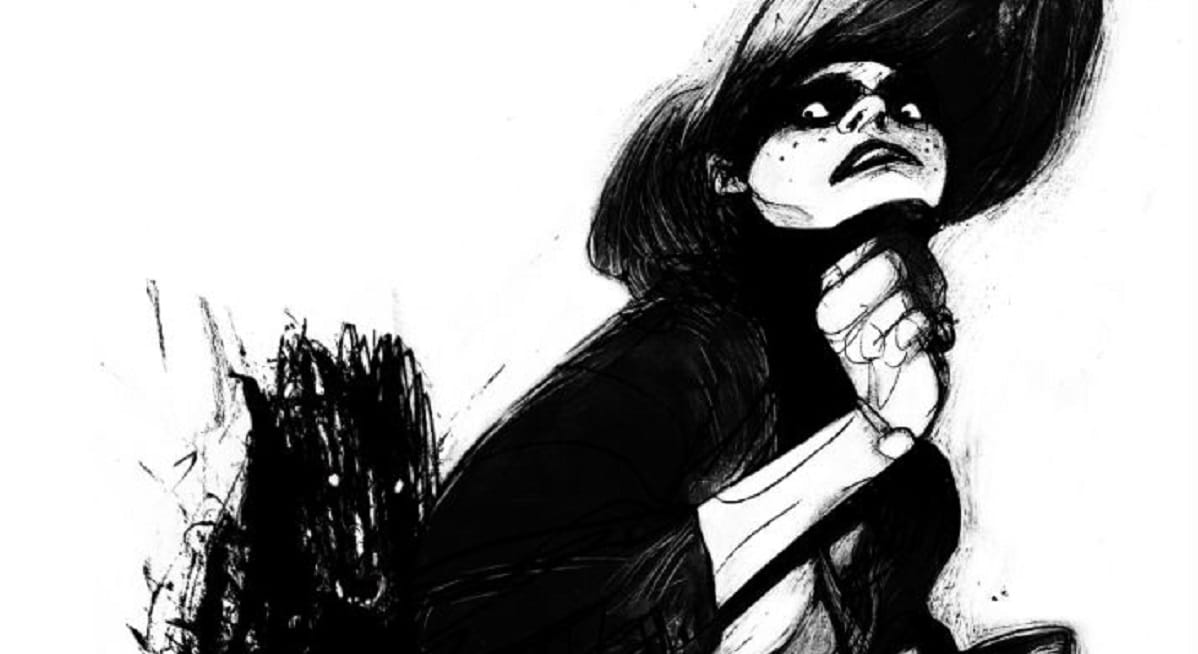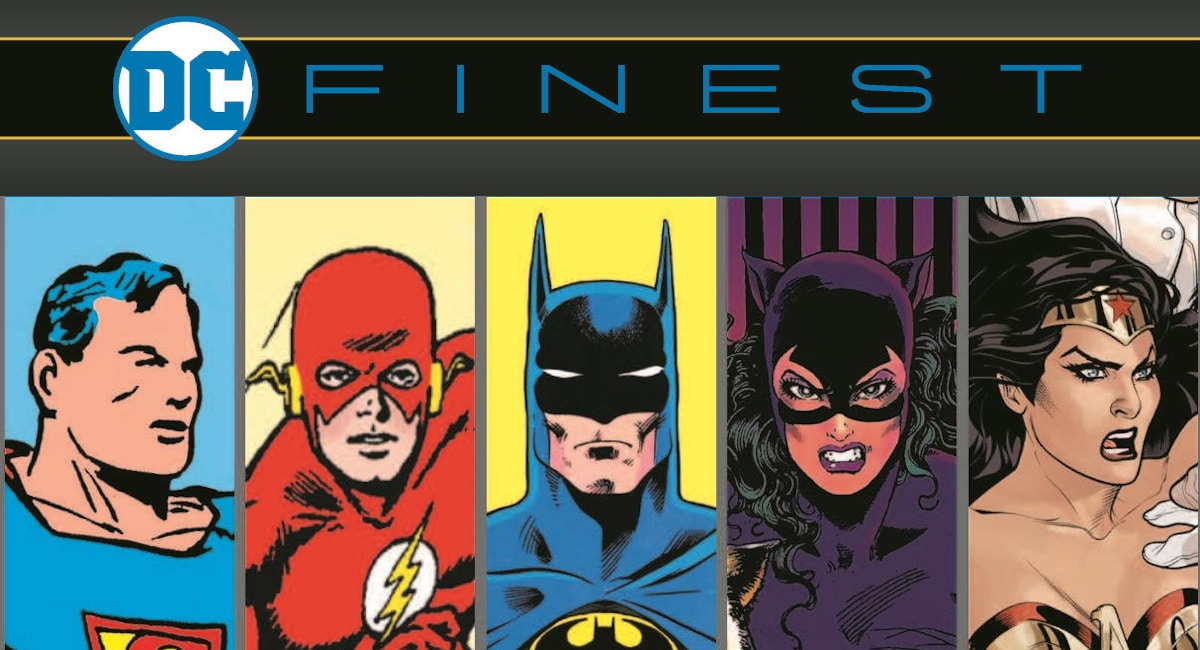 Death Strikes the Emperor of Atlantis
Death Strikes the Emperor of Atlantis
Adapted By
Writer: Dave Maass
Artist: Patrick Lay
Publisher: Dark Horse Comics – Berger Books
Based On The Opera Der Kaiser von Atlantis oder Die Tod-Verweigerung
Librettist: Peter Kien
Composer: Viktor Ullmann
Review by Sean Dillon
When I was a kid, there were two things that could instantly grab my attention: Musicals and the Grim Reaper. There’s been a long, widely documented history of the latter within comics, with creators like Neil Gaiman, Kieron Gillen, and Atsushi Ohkubo all taking a swing at the figure. But the subject of musicals in comics is one that has not been broached. Certainly there have been adaptations and usages of music within comics. Josh Dysart and Cliff Chiang adapted Neil Young’s album Greendale into an underrated comic. Alan Moore frequently placed musical numbers within his comics work (most notable adapting The Threepenny Opera in his viking funeral for English Literature), and Dave Chisholm has made a career in adapting the musical stylings of various artists in brilliant ways.
But the gold standard for adapting music into comics remains P Craig Russell’s The Ring of the Nibelung. Each page is brought to life by Russell’s immaculate penciling. But more importantly is the paneling of the book. Each panel is utilized to express the musicality of the work. Consider, for example, the opening sequence of the comic. An entirely silent four pages depicting the creation of the universe and Odin’s enlightenment. But what makes it sing is the usage of panels. Take, for example, the sequence where Odin loses his eye for knowledge. It’s depicted in a four panel grid atop a yellow box. While the first three panels are depicted in the grid as expected, the fourth panel not only tips the panel slightly clockwise, it also dips it lower than the other three panels, indicating the loss being held. Then, to flow with the previous page, the next panel mirrors that final panel and expands its size, indicating both a flow of imagery as well as an emphasis on the importance of what has just occurred.
Which brings us to Death Strikes The Emperor of Atlantis. Adapted from Der Kaiser von Atlantis oder Die Tod-Verweigerung by Viktor Ullmann and Peter Kien, the graphic novel tells the story of a fascist dictatorship in decline resulting in Death quitting his job out of protest. (Apt given it was written in Theresienstadt.) When reading the graphic novel for the first time, I never realized that this was an early work in both creators’ careers (indeed, this is Dave Maass’ first comic). This is a work that highlights an understanding of the medium and its strengths. Take for example this early scene in the graphic novel:
Over the course of four panels, Patrick Lay’s cartooning shows the emotions of both Death and, albeit for one panel, Pierrot, the manifestation of life. We see Death’s frustration over the mockery the fascist state is making of him for the sake of power. We see Death tighten up as the camera closes in on his face, the darkness overwhelming. And, in a brilliant use of the black and white, Death’s resolve is further entrenched via the billowing smoke of darkness, evoking the horror of war the opera was written under.
But the true genius of the sequence is in the paneling. Up to now, Death Strikes has utilized the De Luca effect to allow its two principle characters to (at times literally) dance through the pages, only using traditional bordered panels for key moments. While not the first usage of panels with borders, it feels intentional on Maass’ part. The first two panels are evenly placed on the same row, highlighting the restraint Death feels in this moment. The third is placed below, directly in-between the two panels above, while at the same time breaking free from the restraints of the panel via the word balloon escaping the panel. (Richard Bruning is doing a fantastic job with the book’s letters.) And the final one, taking over half the page, is free of panel borders, highlighting Death’s resolve.
At the same time, however, there’s a sense that the comic feels restrained by its faithfulness to the words of the opera. As I mentioned above, one of the brilliances of Russell’s adaptation of Der Ring es Nibelingen was his willingness to utilize silence to sing louder than mere words could. In Death Strikes, meanwhile, has no such moment of silence. Sure, there are a very few number of silent sequences in the graphic novel, however they are often single page moments. Indeed, there are points in the graphic novel where it would’ve benefited from silence. For example, the mania of the second chapter and Emperor Overall’s paranoia would have been amplified by the lack of words. Instead, the words utilized slow the reading experience and, at times, actively describing things that appear on the page itself.
Still, this remains a strong first effort from both writer and artist. It’s a fascinating, horrifying, and oddly uplifting opera with fascinating implications and ideas within.
Read more graphic novel reviews in The Beat’s review section.









